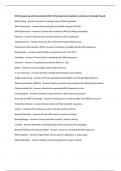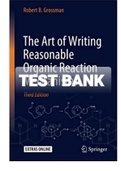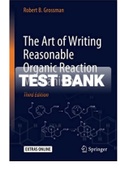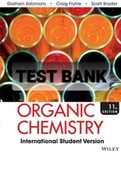Nucleophilic attacks - Study guides, Class notes & Summaries
Looking for the best study guides, study notes and summaries about Nucleophilic attacks? On this page you'll find 29 study documents about Nucleophilic attacks.
Page 3 out of 29 results
Sort by

-
Organic Chemistry 1 Chapters 4, 5 & 6
- Class notes • 10 pages • 2023
- Available in package deal
-
- $10.49
- + learn more
Chapters 4, 5 and 6 introduce naming alkanes (single-bonded carbons) using the IUPAC system. Additionally, students learn how to distinguish between angle strain and torsional strain and how this concept relates to the amount of energy that a molecule holds. Learning about stereoisomerism is essentially to chapter 5 as this plays a role into how two similar (or different) molecules can be classified. Chapter 6 then introduces chemical reactivity and mechanisms of organic molecules. For example, ...

-
DNA Sequencing and Recombinant DNA Technology Exam Questions and Answers Already Passed
- Exam (elaborations) • 3 pages • 2024
- Available in package deal
-
- $7.99
- + learn more
DNA Sequencing and Recombinant DNA Technology Exam Questions and Answers Already Passed DNA Cloning - Answers Process of creating copies of DNA fragments. DNA Sequencing - Answers Determining the nucleotide sequence of DNA. DNA Polymerases - Answers Enzymes that synthesize DNA by adding nucleotides. Helicases - Answers Enzymes that separate DNA strands for replication. Topoisomerases - Answers Enzymes that relieve DNA supercoiling tension. Polymerase Chain Reaction (PCR) - Answers Techniq...

-
ACS Organic Chemistry Semester 1 question and answers
- Exam (elaborations) • 16 pages • 2024
-
- $10.49
- + learn more
formal charge - Correct Answers: group # - lone pairs (NBE) - bonds (1/2 valence electrons) valence electrons - Correct Answers: electrons in the outer most shell Atom - Correct Answers: Smallest particle of an element protons+neutrons surrounded by electrons octet rule - Correct Answers: States that atoms lose, gain or share electrons in order to acquire a full set of eight valence electrons Pauli Exclusion Principle - Correct Answers: An atomic orbital may describe at most ...

-
Exam (elaborations) TEST BANK FOR The Art of Writing Reasonable Organic Reaction Mechanisms 3rd Edition By Robert B. Grossman (Solution Manual)-Converted
- Exam (elaborations) • 237 pages • 2021
-
- $20.49
- + learn more
1.4. Furan has sp2 hybridization. One of the lone pairs is in a p orbital, and the other is in an sp2 orbital. Only the lone pair in the p orbital is used in resonance. 1.5. (a) No by-products. C(1–3) and C(6–9) are the keys to numbering. (b) After numbering the major product, C6 and Br25 are left over, so make a bond between them and call it the by-product. 1.6. (a) Make C4–O12, C6–C11, C9–O12. Break C4–C6, C9–C11, C11–O12. (b) Make C8–N10, C9–C13, C12–Br24. Break O...

-
Exam (elaborations) TEST BANK FOR The Art of Writing Reasonable Organic Reaction Mechanisms 3rd Edition By Grossman
- Exam (elaborations) • 237 pages • 2021
-
- $15.49
- + learn more
Exam (elaborations) TEST BANK FOR The Art of Writing Reasonable Organic Reaction Mechanisms 3rd Edition By Robert B. Grossman (Solution Manual) sp2 hybridization. One of the lone pairs is in a p orbital, and the other is in an sp2 orbital. Only the lone pair in the p orbital is used in resonance. 1.5. (a) No by-products. C(1–3) and C(6–9) are the keys to numbering. (b) After numbering the major product, C6 and Br25 are left over, so make a bond between them and call it the by-product....

-
Exam (elaborations) TETS BANK FOR Organic Chemistry 11th Edition By T. W. Graham Solomons, Craig B. Fryhle, Scott A. Snyder and Jon Antilla (Study Guide and Solutions Manual)
- Exam (elaborations) • 726 pages • 2021
-
- $15.49
- + learn more
Exam (elaborations) TETS BANK FOR Organic Chemistry 11th Edition By T. W. Graham Solomons, Craig B. Fryhle, Scott A. Snyder and Jon Antilla (Study Guide and Solutions Manual) STUDY GUIDE AND SOLUTIONS MANUAL TO ACCOMPANY ORGANIC CHEMISTRY ELEVENTH EDITION T. W. GRAHAM SOLOMONS University of South Florida CRAIG B. FRYHLE Pacific Lutheran University SCOTT A. SNYDER Columbia University ROBERT G. JOHNSON Xavier University JON ANTILLA University of South Florida CONTENTS To the St...

-
CHEMISTRY 2020 Experiment 4: Kinetics of Nucleophilic Substitutions
- Exam (elaborations) • 6 pages • 2023
-
- $10.99
- + learn more
CHEMISTRY 2020 Experiment 4: Kinetics of Nucleophilic Substitutions Chetna Raj June 14th, 2016 Chemistry 2020 Lab 3 Results 1. Determine the effect of varying [OH-] on the rate of the reaction. To do this, you should complete the following table: Table 1: Reaction Rates in Variations of [OH-] Experiment [tBuCl] (M) [OH-] (M) Reaction Time (s) Reaction Rate (M/s) Rate Constant k (s-1) 1 0.03 0.003 44 7.18 × 10-5 2.39 × 10-3 2 0.03 0.006 106 6.32 × 10-5 ...

-
CHEMISTRY 2020 Experiment 4: Kinetics of Nucleophilic Substitutions
- Exam (elaborations) • 6 pages • 2022
-
- $14.49
- + learn more
CHEMISTRY 2020 Experiment 4: Kinetics of Nucleophilic Substitutions Chetna Raj June 14th, 2016 Chemistry 2020 Lab 3 Results 1. Determine the effect of varying [OH-] on the rate of the reaction. To do this, you should complete the following table: Table 1: Reaction Rates in Variations of [OH-] Experiment [tBuCl] (M) [OH-] (M) Reaction Time (s) Reaction Rate (M/s) Rate Constant k (s-1) 1 0.03 0.003 44 7.18 × 10-5 2.39 × 10-3 2 0.03 0.006 106 6.32 × 10-5 ...

-
CHEMISTRY 2020 Experiment 4: Kinetics of Nucleophilic Substitutions
- Exam (elaborations) • 6 pages • 2022
-
- $14.49
- + learn more
CHEMISTRY 2020 Experiment 4: Kinetics of Nucleophilic Substitutions Chetna Raj June 14th, 2016 Chemistry 2020 Lab 3 Results 1. Determine the effect of varying [OH-] on the rate of the reaction. To do this, you should complete the following table: Table 1: Reaction Rates in Variations of [OH-] Experiment [tBuCl] (M) [OH-] (M) Reaction Time (s) Reaction Rate (M/s) Rate Constant k (s-1) 1 0.03 0.003 44 7.18 × 10-5 2.39 × 10-3 2 0.03 0.006 106 6.32 × 10-5 ...

How much did you already spend on Stuvia? Imagine there are plenty more of you out there paying for study notes, but this time YOU are the seller. Ka-ching! Discover all about earning on Stuvia


